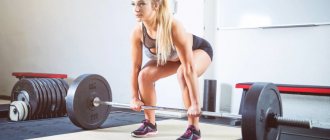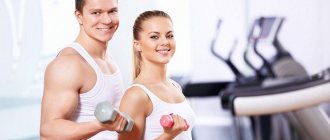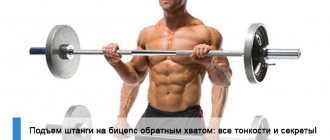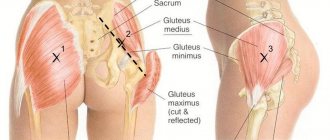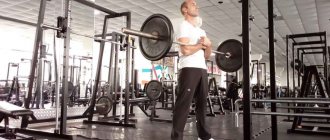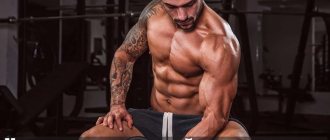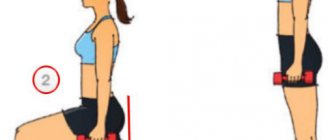The concept of “base” and its difference from insulating loads
Basic strength exercises are those that involve two or more muscle groups at the same time. Another feature of such elements is the inclusion of several joints at once.
In bodybuilding, the classic “base” is:
- squats;
- deadlift;
- bench press
In addition, the concept “basic” can be characterized by:
- pull-ups;
- platform leg press;
- T-bar thrust;
- pushups;
- hack squats,
- all variations of lunges and others.
The main purpose of such elements is to increase muscle volume and increase strength.
Isolation exercises, on the other hand, work one muscle group or even a single muscle. As an example, we can cite almost all the elements performed on simulators:
- Crossover biceps curls;
- bringing your hands together in a “butterfly”;
- lifts in the calf machine;
- sitting leg extension and others.
Isolation loads are poorly suited for developing strength and building large muscle volumes. Their main functions:
- study of the relief;
- training of individual lagging muscles;
- recovery from injuries;
- “replenishment” of tired muscles after the main loads.
The role of isolation exercises in the training process
Isolation exercises are needed for:
- Stronger pumping (blood filling) of the working muscles if performed at the end of the workout. This is also called “finishing” a muscle group.
- Improves neuromuscular communication and pre-fatigue of muscles if performed at the beginning of training.
- Improved muscle relief and proportionality.
- Full training without overloading the joint-ligamentous system and the central nervous system, for example, when recovering from injuries or illnesses.
The effect of basic exercises on muscle growth
It has long been proven that a strength “base” promotes weight gain. This effect is explained by the increased production of endogenous hormones (somatotropin, testosterone) during exercise.
It is important to follow two rules: the duration of the load and its intensity. That is, an athlete-bodybuilder needs to perform at least 3-4 approaches with such a weight that muscle failure occurs in the range of 6 to 12 repetitions.
To increase total body weight, constant progression of loads is also important. With each subsequent workout, it is necessary to increase the weight of the equipment in both basic and isolation exercises. The muscles gradually get used to the load, which leads to an insufficient hormonal response to the training. As a result, a “plateau” state occurs, in which strength indicators do not increase and muscles do not increase in volume.
The best exercises for hands
1) Standing biceps curl is a classic exercise, the main mass-building exercise for increasing the strength and mass of the biceps.
2) Reverse grip pull-ups are a forgotten exercise by many; they are heavy and not entirely comfortable, but they perfectly develop muscle growth in the biceps, while the lats are actively involved in the work.
3) The close-grip bench press is one of the main exercises for the triceps, which allows you to work it out efficiently.
4) Dips are an excellent isolated exercise for targeting the triceps; the main thing is to keep your body straight while doing it, without tilting it forward, in order to minimize the load on the pectoral muscles.
5) French bench press - makes it possible to work with decent working weights, stretches the triceps well and allows you to contract it powerfully. When performing this, the assistance of a insurer is required.
Massive training
The basis of such classes should be basic strength exercises: squat, bench press, deadlift. Beginners are recommended to conduct circuit training aimed at strengthening the body, as well as developing neuromuscular connections. This means that all three basic elements must be completed in one lesson.
Beginning bodybuilders should not do isolation exercises at all in the first 2-3 months. During this period, beginners need to focus on mastering the “basic” technique.
Experienced bodybuilders separate the bench press, squats and deadlifts on separate training days. Isolating loads are added to each basic element to increase tension in the target muscles and focus on lagging muscles.
Recommended structure of exercises for trained athletes: 75–80% should be “base”, 20–25% should be isolation exercises. This amount of training is great for muscle growth.
The best chest exercises
1) The bench press is the king in the development of the pectoral muscles, a basic heavy exercise aimed at increasing muscle mass. Maybe
The most popular exercise among both beginners and experienced athletes.
2) Incline bench press is the main exercise for pumping up the muscles of the upper chest.
3) Dips - few people know that by slightly tilting the body forward, the pecs are actively involved in the work, removing part of the load from the triceps.
4) The dumbbell bench press is a good alternative instead of a barbell, if the growth of the weights has stopped, switch to pressing heavy dumbbells for a while, due to the fact that many stabilizer muscles are involved in the work, the ligaments will be strengthened, the strength will increase, this will help break through the stagnation in the growth of the weights with the help rods.
5) Push-ups are an excellent exercise at home, perfect for strengthening the upper body, and the variety of types of execution will stimulate the growth of different muscle fibers located even deep inside.
Classic basic “three”: bench press, squat, deadlift
These elements are used as the main ones in both bodybuilding and powerlifting. This is explained by the fact that the squat, bench press and deadlift involve large muscle groups.
For example, squats with a barbell simultaneously load the legs, buttocks, thighs, lumbar region, deltoids, and the erector spinae muscles. The result is a powerful hormonal response that promotes weight gain throughout the entire body. In addition, basic exercises strengthen ligaments, tendons and increase the mobility of many joints. As a result, the athlete becomes more resilient and stronger.
Exercises for leg muscles
All athletes know how difficult it is to build leg muscles. Almost no one likes it, but they need to be trained. In most cases, in beginners, the leg muscles are poorly developed and this is due to several reasons. But now we won’t talk about them, but will give advice on how to quickly pump up your legs.
- Try to work on your leg muscles on the first training day of each week and dedicate a separate session for this.
- It is better to pump the quadriceps using the pumping effect, which means performing 12 to 15 repetitions per set. For the muscles of the buttocks and hamstrings, it is better to use a small number of repetitions, from 4 to 6, and work with heavy weight.
- At the end of each training week, pay special attention to your hamstrings.
- Find time to do specific leg training once a week.
- This class requires you to jump on high pedestals, perform sprints at a powerful pace, and jump up and forward.
Basic exercises in bodybuilding
Let's briefly look at the main elements used to grow muscle mass.
For the back:
- Deadlift. Target muscles: spinal extensors and trapezius muscles. The exercise stretches the buttocks and hamstrings well. Recommendation for beginners: master the Romanian deadlift technique, then move on to the deadlift.
- Pull-ups on the bar. Designed to develop the latissimus muscles. The deltoids, chest, and biceps of the arms are worked out. Recommendation for beginners: if you can’t do pull-ups, attach a rubber expander to the horizontal bar to support your legs.
- Bent-over barbell row. The element qualitatively loads the trapezius, latissimus and rhomboid muscles. Additionally, the biceps and lumbar region are used. Recommendation for beginners: you can replace the exercise with a bar row on a lower block.
For chest:
- Bench press. Evenly develops the pectoral muscles. Additionally, the anterior deltas and triceps are worked out. Recommendation for beginners: master the technique of classic presses in the Smith machine.
- Dips. The element is designed to work out the lower edge of the chest. The triceps muscles of the shoulder are well loaded. Recommendations for beginners: avoid this exercise if you feel pain in your shoulder joints.
- Pushups. Used for the qualitative development of pectoral muscles. Additionally, deltoids and triceps are worked out. Recommendations for beginners: use supports under your palms, this will increase the amplitude and strengthen the chest stretch.
For legs:
- Squats. Target muscles: thighs, calves and buttocks. Additionally, the lower back and deltoids are involved. Recommendation for girls: use the squat technique from bodybuilding, as it is better for developing the buttocks.
- Lunges. Designed to train the lower body. When using a barbell as a weight, the deltoids are loaded. Recommendation for girls: perform cross or “Bulgarian” lunges, as they work the buttocks better.
- Leg press in the simulator. This exercise allows you to pump up your lower body well. Used by athletes with back problems. Recommendation for beginners: try different leg positions to shift the emphasis to certain parts of the thigh or gluteal muscles.
For hands:
- Barbell curls for biceps. In addition to the target muscles, deltas, brachialis, and forearm muscles are indirectly involved during execution. Recommendations for beginners: you can replace the barbell with dumbbells or a lower block row in a crossover.
- Close grip press. The element is used for accentuated training of the triceps muscles of the shoulder. The front deltoids are additionally loaded. Recommendations for beginners: to master the correct technique, perform the exercise on a Smith machine.
- Narrow push-ups and pull-ups with a reverse grip. Elements are used to develop the triceps and biceps brachii muscles. Additionally, both exercises work the front deltoids and strengthen the muscles of the forearms.
For shoulders:
- Barbell row to the chin. Target muscles: anterior and middle deltoids. The biceps, upper chest and trapezius are indirectly involved. Recommendation for beginners: you can replace the barbell using the traction bar in the crossover.
- Seated barbell press. The deltoid muscles (anterior and middle bundles) receive the main load. Additionally, the following are worked: trapezius, triceps and upper chest. Recommendations for beginners: perform the element in a Smith machine.
- Reverse leads in the “butterfly”. Used to develop the posterior heads of the deltoids. The exercise involves the infraspinatus, trapezius, rhomboid and teres minor muscles of the back.
The presented exercises are used to grow muscle mass, which means they should be performed in 3-4 sets of 6-12 repetitions. We recommend that beginner athletes engage in bodybuilding under the guidance of an experienced mentor.
Basic or isolation exercises: which is better?
You've probably heard other people say "basic exercises" or "isolation exercises." They may sound like complex bodybuilding terms, but in fact there is nothing complicated about these concepts. Now I will immerse you in the world of basic and isolation exercises and show you which exercises should be preferred in the training process.
Basic exercises
Basic exercises are exercises that target a large number of muscles at a time, that is, they work several large muscle groups at once. A very good example is squats. In addition to the fact that this exercise actively affects the core muscles (abs), it also puts stress on the quadriceps , hamstrings , calves , buttocks and even the lower back . Seven muscle groups work at once!
Since basic exercises target a large number of muscles, they help burn more calories than isolation exercises. In addition, it is worth noting that performing basic exercises can effectively reduce training time! Think for yourself: in one exercise you train up to 5 muscle groups, or even more! Another feature of basic exercises is that most of them are a simulation of real actions that you perform in everyday life. And that’s why they also allow you to develop reaction speed and reduce the risk of injury.
Here are examples of some basic exercises:
- Deadlift
- Lunges with barbell/dumbbells
- Bench press
- Pulling up
- Push ups
- Dumbbell press
- Bent-over barbell row
Isolation exercises
isolation exercises are , or isolated exercises , as they are also often called.
Isolation exercises, unlike basic ones, are aimed at a separate muscle group. An example of an isolation exercise would be a biceps curl. Since we are only doing elbow bends, we are working exclusively on the biceps.
Isolation exercises are often prescribed as therapy for people who are unable to work certain muscle groups. Also, isolation exercises are an excellent remedy for muscle imbalance (this is when you have some muscles that are better developed than others). In addition, you should not lie and note the main feature of isolation exercises - this is that they allow you to effectively increase muscle size, since the entire load goes to individual muscles - they receive the greatest stress and, as a result, increase in size. The above mentioned exercise, biceps curl , is the right way to increase the size of your biceps muscles.
Some isolation exercises:
- Extension of arms with a barbell from behind the head;
- Dumbbell lateral raises;
- Lifting dumbbells in front of you;
- Leg extension in the simulator;
- Lying leg curls
What is better: isolation or basic exercises?
Regardless of your experience in the fitness environment, many instructors recommend practicing basic exercises most of the time during training. As for those in isolation, they are given much less time. Some instructors, on the contrary, give their clients only training with isolation exercises or exercises in a simulator.
I believe that there should be balance in everything. At least one exercise per workout should be basic. If it’s the back, then pull-ups and bent-over rows. If these are the pectoral muscles, then the bench press (I prefer the version with dumbbells, but then the question is - doesn’t this stop being basic?). It is wrong to think that only basic exercises grow muscles. One or two heavy basic exercises in training and three or four lighter isolation exercises are the basis for a successful workout.
As for beginners, I do not recommend doing basic exercises in the first months of training. It's my personal opinion. I see beginners doing curved barbell bench presses with minimal weight. What will they pump up this way? It’s better to do the same chest press in a machine where the range of motion is already set and you don’t have to chase the weights in front of everyone else in the gym.
There are basic exercises that I believe should not be done at a later stage. For example, deadlift. Yes, this is a very powerful exercise, but how many people have been injured doing it?
Training plans
Let's look at two options that you can rely on when building your own workout.
Men's program "for mass"
The plan is designed for athletes who have 3-4 months of strength training experience and have mastered the techniques of basic elements.
Lesson 1. Target - chest muscles, biceps:
- Warm up: any cardio machine - 7-10 minutes.
- Bench press (horizontal bench) - 4x8.
- Dumbbell flyes - 3x12.
- Incline dumbbell press – 3x12.
- Dips - 3x15.
- Reduction of arms in a butterfly simulator - 3x12.
- Barbell curl for biceps - 3x12.
- Roman chair crunches – 3x25.
Lesson 2. Target - back muscles, triceps:
- Warm up: any cardio machine - 7-10 minutes.
- Deadlift - 4x8.
- Upper block pull behind the head - 3x12.
- Bent-over barbell row – 3x12.
- Bent-over dumbbell row with one arm - 3x12.
- Hyperextensions - 3x12.
- Close grip bench press - 3x12.
- Crunches on the floor - 3x25.
Lesson 3. Target - leg muscles, deltas:
- Warm up: any cardio machine - 7-10 minutes.
- Calf raises in a vertical machine - 3x20.
- Barbell squats - 4x8.
- Lunges with weights - 3x12.
- Leg press in the simulator - 3x12.
- Standing barbell press - 3x12.
- Reverse abductions in the butterfly simulator - 3x12.
- Crossover prayer crunches - 3x20.
Program for girls
Women's basic exercises in the gym do not differ in technique from men's. The only difference is the weight of the equipment and the number of repetitions in the sets.
Lesson 1. Target - chest, arms:
- Warm up: any cardio machine - 10-15 minutes.
- Smith machine bench press - 3x12-15.
- Dumbbell flyes – 3x12–15.
- Crossover biceps curls – 3x12–15.
- French press – 3x12–15.
- Bicycle crunches - 3x20.
Lesson 2. Target - back, shoulders:
- Warm up: any cardio machine - 10-15 minutes.
- Pull-ups (gravitron) - 3 to failure.
- Romanian deadlift – 3x12–15.
- Vertical dumbbell press – 3x12–15.
- Reverse abductions in the butterfly simulator - 3x12–15.
- Plank - 4 sets of 30 seconds.
Lesson 3. Target - legs, buttocks:
- Warm up: any cardio machine - 10-15 minutes.
- Squats in Smith (emphasis on the buttocks) - 3x12-15.
- Cross lunges with dumbbells - 3x12-15.
- Leg extension while sitting in a machine - 3x12–15.
- Leg bending while lying in a machine - 3x12–15.
- Fitball crunches - 3x20.
The program can be used by both beginner and experienced athletes. After 2 months, change the plan. If you need to lose weight, add 2 light runs per week on rest days.
Best Shoulder Exercises
1) Bench press from behind the head is a basic exercise for developing the middle deltoids, remember that the grip should be such that the forearms at the bottom point are parallel to each other, the bar itself should not be lowered below the ears.
2) The seated dumbbell press is an alternative to the overhead bench press; due to the more comfortable position of the shoulders without a fixed rigid position, this type of exercise is less traumatic.
3) The chest press is a good exercise for developing the front part of the deltas, it is characterized by good efficiency and mass-building impact.
4) Dumbbell swings to the sides - a targeted blow for the development of the middle section of the deltas, must be performed after the main bench press exercises of a barbell or dumbbells.
5) Military press - perfectly develops the entire shoulder girdle, but be careful, this is a traumatic exercise if the technique for the lower back is violated, the use of a belt is mandatory.
Basic Training FAQ
Let's look at popular questions that novice athletes ask.
Question: What does “making a base” mean?
Answer : this means performing a basic exercise. Typically, the expression applies to the strength “troika”: deadlift, bench press and squats. These elements are used in powerlifting and bodybuilding as the basis of all training. Therefore, the phrase “making a base” can be found in both disciplines.
Question: Are basic exercises good for losing weight?
Answer : they are suitable because they consume a large number of calories. In addition, the “base” must be supplemented with cardio exercises. The combination of strength and aerobic training helps to effectively cope with excess weight. We recommend 3 gym sessions per week and 2 cardio sessions of 45-60 minutes each on rest days.
Question: Is there a “base” for abs?
Answer : The plank can be considered conditionally “basic”, since in addition to the abdominal muscles, it works the shoulders, hips, buttocks, and lower back. All other elements for the press are isolating, as they place an accentuated load on the rectus abdominis or oblique muscles. But this does not mean that they are ineffective. On the contrary, strength isolating exercises, such as Roman chair crunches with weights, help increase the thickness of the abdominal muscles and work out the relief.
Question: how many basic elements to do per workout?
Answer : Beginner athletes can perform bench press, deadlift and deadlift in one session. The weight of the equipment should be such that a beginner can do 10-12 repetitions in each set without failure. For experienced bodybuilders, we recommend using the classic three-day split scheme with the division of basic elements into classes.
Question: is it possible to do only basic exercises?
Answer : at the initial stage - yes, it is possible. Beginners are generally not recommended to use insulating loads. Beginning bodybuilders should focus on mastering the technique of the basic elements. This will help strengthen large muscles, ligaments, tendons and develop the necessary connection between the brain and muscle fibers.
Question: is it possible to effectively make a “base” at home?
Answer : no, you can't. The fact is that basic exercises performed only with your own body weight are ineffective for gaining muscle mass. If you want to develop bulky muscles, join a good fitness center and buy a few training sessions from an experienced mentor.
Question: How dangerous is axial load in basic exercises?
Answer : such a load is dangerous for beginners who have not mastered the technique and who immediately lift heavy weights, as well as for people with spinal injuries. If you have back problems, we recommend avoiding power squats and deadlifts. Instead, perform safe exercises such as platform leg presses or hyperextensions.
Question: Is hyperextension a basic or an isolation element?
Answer : a controversial point, many athletes disagree. We consider hyperextension to be a basic exercise because it targets several large muscles: the spinal extensors, hamstrings, and glutes. The element can be insulating if the back is slightly rounded. In this case, the load will fall exclusively on the gluteal muscles.
BACK
- Wide-grip chest pull-ups
Everyone knows this exercise. The best of the best. One of the most effective exercises for developing the latissimus dorsi muscles... that is, FOR DEVELOPING A POWERFUL V-SHAPED BACK.. This is probably the most popular/ancient and at the same time easily accessible exercise, which I would never ignore .
When performing it, the entire upper shoulder girdle is involved: the latissimus dorsi, shoulders (mainly the anterior bundle), trapezius (by the way, they are very heavily loaded), forearms (also actively plowed) and arm muscles (biceps, brachialis, too active for most people) and even CHEST and TRICEPS. This exercise forms the BASIS in training the back muscles of all (if not all, then the absolute majority) athletes.
There is an equally effective replacement for this exercise - pulling a vertical block to the chest:
The vertical block row imitates pull-ups (this is analogous), the only difference is that in pull-ups we attract (pull up) our body to the projectile (crossbar), and in the vertical block row we attract the projectile to the body, and of course, in the vertical For deadlifts, it is possible to set a small weight (or medium), this is useful for those who do not know how to do pull-ups (can’t, they don’t have enough strength), for girls, etc. That's all. As for the muscles, the same ones work.
For many people, pulling a vertical block to the chest will be even more effective than pull-ups, because pull-ups are a very, very difficult EXERCISE (both PHYSICALLY and TECHNICALLY), as a result, as practice shows, many people do pull-ups WRONG! They jerk jerkily, just to pull themselves up, they don’t feel the back muscles, they pull themselves up mainly due to the strength of the biceps, in general, for many people (who don’t know how to pull themselves up correctly), the pull-down of a vertical block to the chest is better suited because of the fact that we have the opportunity to put on medium or even light weights and clearly work out the technique (learn to turn off the biceps from work, perform traction using the back muscles), this will be much more effective than jerking on the horizontal bar, haphazardly, if only it was possible.
I recommend studying the main article: “How to pump up a wide back.”


